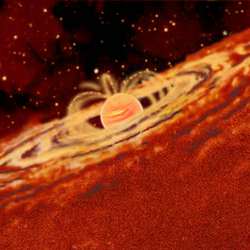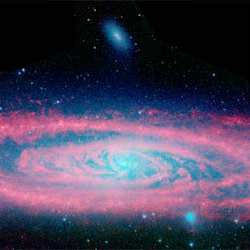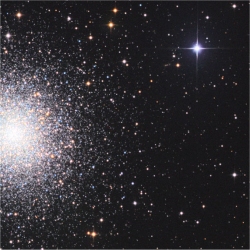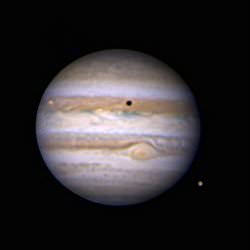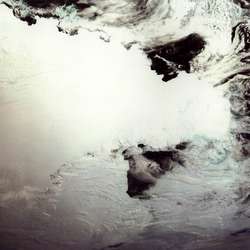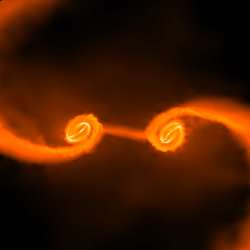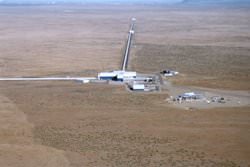
Arial photograph of LIGO. Image credit: LIGO. Click to enlarge.
In the past, astronomers could only see the sky in visible light, using their eyes as receptors. New technologies extended their vision into different spectra: infrared, ultraviolet, radio waves, x-rays and gamma rays. But what if you had gravity eyes? Einstein predicted that the most extreme objects and events in the Universe should generate gravity waves, and distort space around them. A new experiment called Laser Interferometer Gravitational Wave Observatory (or LIGO) could make the first detection of these gravity waves.
Listen to the interview: Seeing with Gravity Eyes (7.9 MB)
Or subscribe to the Podcast: universetoday.com/audio.xml
What’s a Podcast?
Fraser Cain: All right, so what is a gravity wave?
Dr. Sam Waldman: So a gravity wave can be explained if you remember that mass distorts spacetime. So if you remember the analogy of a sheet pulled taut with a bowling ball tossed into the middle of the sheet, bending the sheet; where the bowling ball is a mass and the sheet represents spacetime. If you move that bowling ball back and forth very rapidly, you’ll make ripples in the sheet. The same thing is true for masses in our Universe. If you move a star back and forth very rapidly, you will make ripples in spacetime. And those ripples in spacetime are observable. We call them gravity waves.
Fraser: Now if I’m walking around the room, is that going to cause gravity waves?
Dr. Waldman: Well it will. As far as we know, gravity works at all scales and for all masses, but spacetime is very stiff. So something like my 200 pound self moving through my office won’t cause gravity waves. What are required are extremely massive objects moving very rapidly. So when we look to detect gravity waves, we’re looking for solar mass scale objects. In particular, we search for neutron stars, which are between 1.5 and 3 solar masses. We look for black holes, up to several hundred solar masses. And we look for these objects to be moving very rapidly. So when we talk about a neutron star, we’re talking about a neutron star moving at almost the speed of light. In fact, it has to be vibrating at the speed of light, it can’t just be moving, it has to be shaking back and forth very rapidly. So, they’re very unique, very massive cataclysmic systems that we’re searching for.
Fraser: Gravity waves are purely theoretical, right? They were predicted by Einstein, but they haven’t been seen yet?
Dr. Waldman: They’ve not been observed, they’ve been inferred. There is a pulsar system whose frequency is spinning down at a rate consistent with the emission of gravity waves. That’s PSR 1913+16. And that the orbit of this star is changing. That’s an inference, but of course, that’s not an observation directly of gravity waves. However, it’s pretty clear that they have to exist. If Einstein’s laws exist, if General Relativity works, and it works very well at very many length scales, then gravity waves exist too. They’re just very difficult to see.
Fraser: What’s it going to take to be able to detect them? It sounds like they’re very cataclysmic events. Great big black holes and neutron stars moving around, why are they so difficult to find?
Dr. Waldman: There’s two components to that. One thing is that black holes don’t collide all the time, and neutron stars don’t shake about in just any old place. So the number of events that can cause observable gravity waves is actually very small. Now we talk about, for example, the Milky Way galaxy with one event occuring every 30-50 years.
But the other part of that equation is that gravity waves themselves are very small. So they introduce what we call a strain; that’s a length change per unit length. For instance, if I have a yardstick one metre long, and a gravity wave will squish that yardstick as it comes through. But the level that it will squish the yardstick is extremely small. If I have a 1-metre yardstick, it will only induce a change of 10e-21 metres. So it’s a very very small change. Of course, observing 10e-21 metres is where the large challenge is in observing a gravity wave.
Fraser: If you were measuring the length of a yardstick with another yardstick, the length of that other yardstick would be changing. I can see that being difficult to do.
Dr. Waldman: Exactly, so you have a problem. The way we solve the yardstick problem is that we actually have 2 yardsticks, and we form them into an L. And the way we measure them is to use a laser. And the way that we have arranged our yardstick is actually in a 4-km long “L”. There’s 2 arms, each one’s 4 km long. And at the end of each arm there’s a 4-kg quartz test mass that we bounce lasers off of. And when a gravity wave comes through this “L” shaped detector, it stretches one leg while it shrinks the other leg. And it does this at say 100 hertz, within audio frequencies. So if you listen to the motion of these masses, you hear a buzzing at 100 hertz. And so what we measure with our lasers is the differential arm length of this large, “L” shaped interferometer. That’s why it’s LIGO. It’s the Laser Interferometer Gravitational-Wave Observatory.
Fraser: Let’s see if I understand this correctly. Billions of years ago a black hole collides with another and generates a bunch of gravity waves. These gravity waves cross the Universe and wash past the Earth. As they go past the Earth, they’re lengthening one of these arms and they’re shrinking the other one, and you can detect this change by that laser bouncing back and forth.
Dr. Waldman: That’s right. The challenge, of course, is that that length change is extremely small. In the case of our 4km interferometers, the length change that we measure right now is 10e-19 metres. And to put a scale on that, the diameter of an atomic nucleus is only 10e-15 metres. So our sensitivity is subatomic.
Fraser: And so what kinds of events should you be able to detect at this point?
Dr. Waldman: So that’s actually a fascinating area. The analogy we like to use is like it’s looking at the Universe with radio waves was to looking at the Universe with telescopes. The things you see are totally different. You’re sensitive to a totally different regime of the Universe. In particular, LIGO is sensitive to these cataclysmic events. We classify our events into 4 broad categories. The first one we call bursts, and that is something like a black hole forming. So a supernova explosion occurs, and so much matter moves so rapidly that it forms black holes, but you don’t know what the gravity waves look like. All you know is that there are gravity waves. So these are things that happen extremely rapidly. They last for 100 milliseconds at the most, and they come about from the formation of black holes.
Another event we look at is when two objects are in orbit with each other, say two neutron stars orbiting each other. Eventually the diameter of that orbit decays. The neutron stars will coalesce, they will fall into each other and form a black hole. And for the very last few orbits, those neutrons stars (keep in mind they’re objects that weigh 1.5 to 3 solar masses), are moving at large fractions of the speed of light; say 10%, 20% of the speed of light. And that motion is a very efficient generator of gravity waves. So that’s what we use as our standard candle. That’s what we think we know exists; we know they’re out there, but we aren’t sure how many of them are going off at any one time. We’re not sure what a neutron star in spiral looks like in radio waves, or x-rays, in optical radiation. So it’s a little bit difficult to calculate exactly how often you’ll see either an in-spiral or a supernova.
Fraser: Now will you be able to detect their direction?
Dr. Waldman: We have two interferometers. In fact we have two sites and three interferometers. One interferometer is in Livingston Louisiana, which is just north of New Orleans. And our other interferometer is in eastern Washington state. Because we have two interferometers, we can do triangulation in the sky. But there is some uncertainty left in where exactly the source is. There are other collaborations in the world that we work with quite closely in Germany, Italy, and Japan, and they also have detectors. So if multiple detectors in multiple sites see a gravity wave, then we can do a very good job in localizing. The hope is that we see a gravity wave and we know where it comes from. We then tell our radio astronomers colleagues and our x-ray astronomer colleagues, and our optical astronomer colleagues to go look at that portion of the sky.
Fraser: There are some new large telescopes on the horizon; overwhelmingly large and gigantically large, and Magellan… the big telescopes coming down the pipe with fairly large budgets to spend. Let’s say that you can reliably find gravity waves, it’s almost like it adds a new spectrum to our detection. If large budgets were put into some of these gravity wave detectors, what do you think they could be used for?
Dr. Waldman: Well, as I said before, it’s like the revolution in astronomy when radio telescopes first came online. We’re looking at a fundimentally different class of phenomena. I should say that the LIGO laboratory is a fairly large laboratory. We’re over 150 scientists working, so it’s a large collaboration. And we hope to collaborate with all of the optical and radio astronomers as we go forward. But it’s a little difficult to predict what path that science will take. I think if you speak to a lot of general relativists, the most exciting feature of gravity waves is that we’re doing something called Strong Field General Relativity. That is all the General Relativity you can measure looking at stars and galaxies is very weak. There’s not a lot of mass involved, it’s not moving very fast. It’s at very large distances. Whereas, when we’re talking about the collision of a black hole and a neutron star, that very last bit, when the neutron star falls into the black hole, is extremely violent and probes a realm of general relativity that just isn’t very accessible with normal telescopes, with radio, with x-ray. So the hope is that there are some fundamentally new and exciting physics there. I think that’s what primarily motivates us is, you could call it, fun with General Relativity.
Fraser: And when do you hope to have your first detection.
Dr. Waldman: So the LIGO interferometers – all three interferometers – that LIGO operates are all running at design sensitivities, and we are currently in the middle of our S5 run; our fifth science run, which is a year-long run. All we do for a year is try to look for gravity waves. As with a lot of things in astronomy, most of it is wait and see. If a supernova doesn’t explode, then we’re not going to see it, of course. And so we have to be online for as long as possible. The probibility of observing an event, like a supernova event, is thought to be in the region of – at our current sensitivity – it’s thought that we’re going to see one every 10-20 years. There’s a large range. In the literature, there are folks who claim that we will see multiple per year, and then there are folks who claim that we won’t see any ever at our sensitivity. And the conservative middle ground is once every 10 years. On the other hand, we’re upgrading our detectors as soon as this run is over. And we’re improving the sensitivity by a factor of 2, which would increase our detection rate by a factor of 2 cubed. Because sensitivity is a radius, and we’re probing a volume in space. With that factor of 8-10 in detection rate, we should be seeing an event once every year or so. And then after that, we’re upgrading to what’s called Advanced LIGO, which is a factor of 10 improvement in sensitivity. In which case we will almost definitely be seeing gravity waves once every day or so; every 2-3 days. That instrument is designed to be a very real tool. We want to do gravity astronomy; to be seeing events every few days. It’ll be like launching the Swift satellite. As soon as Swift went up, we started seeing gamma ray bursts all the time, and Advanced LIGO will be similar.
